Pumpkin Cake Roll
This pumpkin roll features a light, tender cake with just the right balance of warm spice and sweetness, wrapped around a smooth cream cheese filling. It's easy to make ahead and stays moist and flavorful for days.
Servings: 12 Servings
Ingredients
Cake
- 3 large eggs at room temperature
- 1 cup granulated sugar 198 grams
- ⅔ cup pumpkin puree 177 grams
- 1 teaspoon vanilla extract
- ¾ cup all-purpose flour 90 grams
- 1 teaspoon baking powder
- ½ teaspoon baking soda
- 1½ teaspoons ground cinnamon
- 1½ teaspoons pumpkin pie spice
- ½ teaspoon salt
Filling
- 8 ounces cream cheese softened, 227 grams
- 6 tablespoons unsalted butter softened, 85 grams
- 1 ½ cups powdered sugar 169 grams
- 1 teaspoon vanilla extract
- ⅛ teaspoon salt
Instructions
- Preheat the oven to 375°F. Grease a 10x15-inch jelly roll pan and line it with parchment paper, leaving some overhang on the short ends. Lightly grease the parchment.

- In a large mixing bowl, beat the eggs and sugar on medium-high speed for 3 to 4 minutes, until the mixture is thick, pale, and creamy. It should at least double (almost triple) in volume and fall from the beaters in thick ribbons that briefly sit on the surface before disappearing.

- Beat in the pumpkin purée and vanilla extract until smooth.

- Set a sifter over the bowl and sift in the flour, baking powder, baking soda, cinnamon, pumpkin pie spice, and salt. Gently fold the dry ingredients into the pumpkin mixture with a wide spatula.
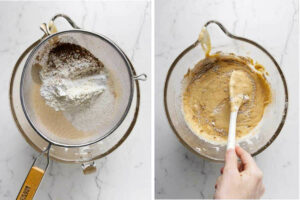
- Spread the batter evenly into the prepared pan, smoothing the top. Bake for 13 to 16 minutes, or until the cake springs back when lightly touched.
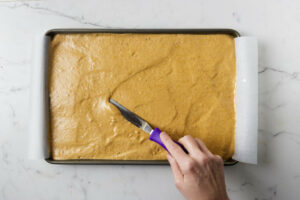
- Remove the cake from the oven and let it rest in the pan for 2 minutes. Loosen the edges with a knife. Lightly spray a new sheet of parchment with nonstick spray and invert the warm cake onto it. Peel off the baked parchment.
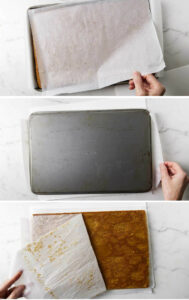
- Using the sprayed parchment, gently roll the cake from the short end. Let it cool completely while rolled, seam side down.
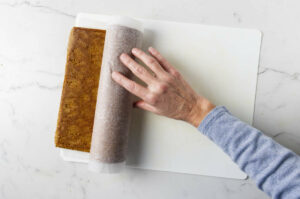
Make the Filling
- In a medium bowl, beat the cream cheese and butter until smooth and creamy, scraping down the sides of the bowl halfway through to make sure everything mixes evenly. Add the powdered sugar and vanilla, and beat until light and fluffy.
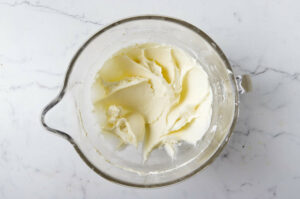
- Once the cake has cooled, carefully unroll it. Spread the filling evenly over the surface, leaving a small border at the edges.
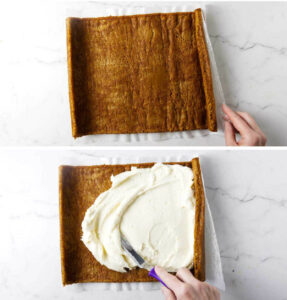
- Re-roll the cake gently but firmly with the filling inside. Place seam side down on a serving platter. Refrigerate for at least 1 hour before slicing.

- Dust with powdered sugar before serving. Store leftovers in the refrigerator.
Notes
Even baking: Spread the batter all the way into the corners and level the top. A thin, even layer helps the cake bake evenly.
Texture check: The cake should spring back lightly when touched in the center and pull just slightly from the edges of the pan. If it’s over-baked, it may crack when rolled.
About the eggs: Make sure the eggs are truly at room temperature before beating. Cold eggs won’t whip up as much volume, which affects the cake’s texture and flexibility.
Filling consistency: For the smoothest filling, make sure both the butter and cream cheese are completely softened before mixing. If the filling seems too soft to spread, chill it briefly before using.
Prevent cracks: Roll the cake while it’s still warm. Using the parchment will prevent it from sticking together.
Cooling time: Let it cool completely before adding the filling or it will melt and seep out. Then let the cake cool in the fridge for at least an hour before slicing.
Storage: The cake can be made one to two days ahead. Wrap snuggly in plastic wrap and refrigerate.
Freezing: Wrap the finished roll (or individual slices) in plastic wrap, then foil, and freeze for up to one month. Thaw in the refrigerator overnight.
Serving tip: For clean slices, wipe the knife between cuts.
Nutrition
Serving: 1serving | Calories: 291kcal | Carbohydrates: 40g | Protein: 4g | Fat: 13g | Saturated Fat: 8g | Polyunsaturated Fat: 1g | Monounsaturated Fat: 4g | Trans Fat: 0.2g | Cholesterol: 75mg | Sodium: 279mg | Potassium: 83mg | Fiber: 1g | Sugar: 33g | Vitamin A: 2608IU | Vitamin C: 1mg | Calcium: 55mg | Iron: 1mg
